This is Part III of my series of posts relating to the Japanese cultural phenomenon called “ero-guro-nansensu”, or erotic-grotesque-nonsense. Part II, which discussed the cultural contributions of Edogawa Rampo, is found here.
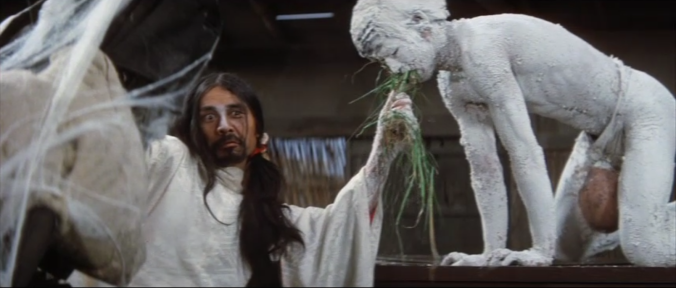
The mad Doctor Komoda and one of his ‘malformed men’ whom, it would appear, possesses a football-sized scrotum.
Horrors of Malformed Men
(1969, dir. Teruo Ishii, a.k.a. Horror of a Deformed Man or The Horror of Malformed Men)
The first film I’d like to discuss in my Deviant Desires series is Teruo Ishii’s “pinky violent” contribution to the ero-guro landscape entitled Horrors of Malformed Men. By the time Ishii came to helm this film, he had already enjoyed a long and very prolific career as a director. His filmography consists of over 80 films, including the much-beloved children’s science-fiction series Super Giant, and — at the very opposite end of the cinematic spectrum — the infamous sex-and-sadism film Shogun’s Joy of Torture (1968). He was frequently referred to in Japan as “The King of Cult”.
Horrors of Malformed Men is best described as avant-garde theatre meets exploitation film. It’s a hodge-podge of at least four different Edogawa Rampo stories, including “The Human Chair”, ‘The Stroller in the Attic’, ‘The Twins’, and the title story ‘The Strange Tale of Panorama Island’. This film also draws heavily on H.G. Wells’s novel “The Island of Dr. Moreau”, as well as the 1932 film adaptation entitled “Island of Lost Souls”. Ishii fashioned these different Rampo stories around an overarching tale of an amnesiac young doctor’s search for his missing father.
Often labeled under the category “pink film” — which was a type of Japanese softcore pornographic theatrical film produced in the 1960’s and 70’s — the nudity and sex on display in Horrors of Malformed Men is certainly tame by contemporary standards. Even in the Japan of 1969, the occasional glimpses of bare breasts and bum that flash across the screen wouldn’t have alerted the ever-vigilant eyes of the censors. The violence in this film is minimal, and it’s not especially gory nor horrific for a film entitled Horrors of Malformed Men. So, why was it banned in Japan? (Note the text “Banned for Decades! The most notorious Japanese horror film EVER made” emblazoned across the top of the DVD case.) The answer is — quite surprisingly — political correctness in the 1970’s.
Edogawa Rampo zenshu: kyofu kikei ningen
You can use many terms in Japanese to describe malformed or disfigured people, but the one that was actually used in the Japanese title (see above) was the most negative and derogatory possible. Compounding this issue was also the fact that deformity has traditionally been considered a social taboo in Japan, so much so that to have a member of your family born with a congenital deformity was considered a shameful “loss of face” to the entire family. It was likely due to the strong negativity of these traditionally-held beliefs regarding the disabled that the ‘politically correct’ reaction against them in the 1970s may have overcompensated for the years of discrimination.
Describing the plot of Horrors of Malformed Men is a near impossible task, as it contains plot twists so numerous that to chart them all would prove daunting. The story begins with a young doctor named Hirosuke who suddenly finds himself imprisoned inside an asylum. The story also involves two murders, circus performers, hunchbacks, topless girls, snakes, more topless girls, and a mysterious double named Genzaburo whom Hirosuke impersonates upon his death. A series of strange events compels Hirosuke to seek out answers from Genzaburo’s estranged father who lives on a secluded island. On arrival, Hirosuke and his entourage encounter Genzaburo’s father, who is the unhinged doctor Jogoro Komoda. Similar to Dr. Moreau of the H.G. Well’s novella, the mad Jogoro has been subjecting poor kidnapped individuals to nightmarish medical experiments, all for the purpose of creating his utopia of “malformed men.”
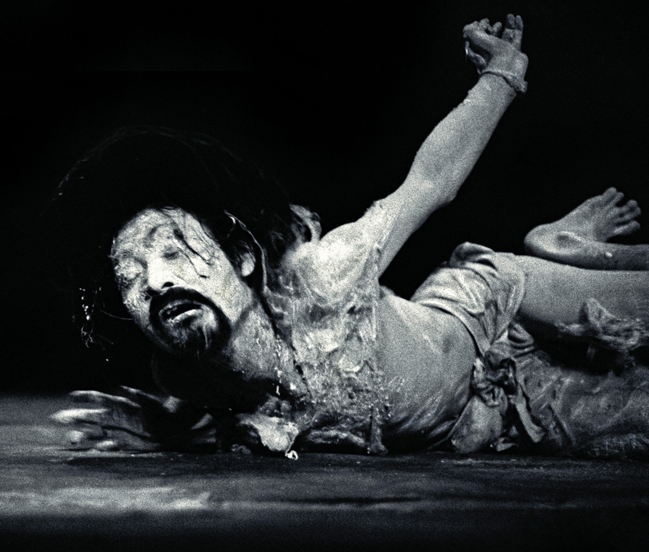
Tatsumi Hijikata, who was one of the founders of the avant-garde theatre and dance movement called butoh.
Director Teruo Ishii made a rather inspired choice in his casting of Jogoro Komoda. Rather than an actor, he cast the performance artist and dancer, Tatsumi Hijikata to play the unhinged doctor. Hijikata was the founder of the avant-garde butoh movement in Japan. Created as a reaction to Western forms of dance, which reached upwards towards the divine, Hijikata’s “dark butoh” saw contorted forms writhing on the ground in a tormented display of anguish. Inspiration often came from discomfiting places, such as the movements of the handicapped and the mentally ill. Hijikata famously described the dance as “a corpse trying desperately to stand upright”. Butoh performers cover their bodies with white make-up and move in strange, disjointed, often contorted movements. Incidentally the actress Takako Fuji, who portrayed Kayako Saeki from The Grudge is a trained modern dancer who borrowed heavily from the tradition of butoh for her character’s unnerving movements.
My favourite scene from Horrors of Malformed Men opens with the improvised dance of Hijikata (a sequence that Ishii liked so much that he featured it in the film twice). Then, after a brief discussion with Hirosuke, the mad Jogoro takes his visitors on a tour of his island and his “creations.” They witness troupes of butoh dancers performing an array of grotesque tableaux in and around the water. We see hunchbacks with whips lashing screeching, half-naked monkey-women, two strange human-goat hybrid creatures, naked women swimming and behaving as if they were koi fish, and the performance of some mysterious, arcane ritual by the water’s edge.
Next up, Hiroshi Harada’s infamous underground anime Midori — The Girl in the Freak Show.
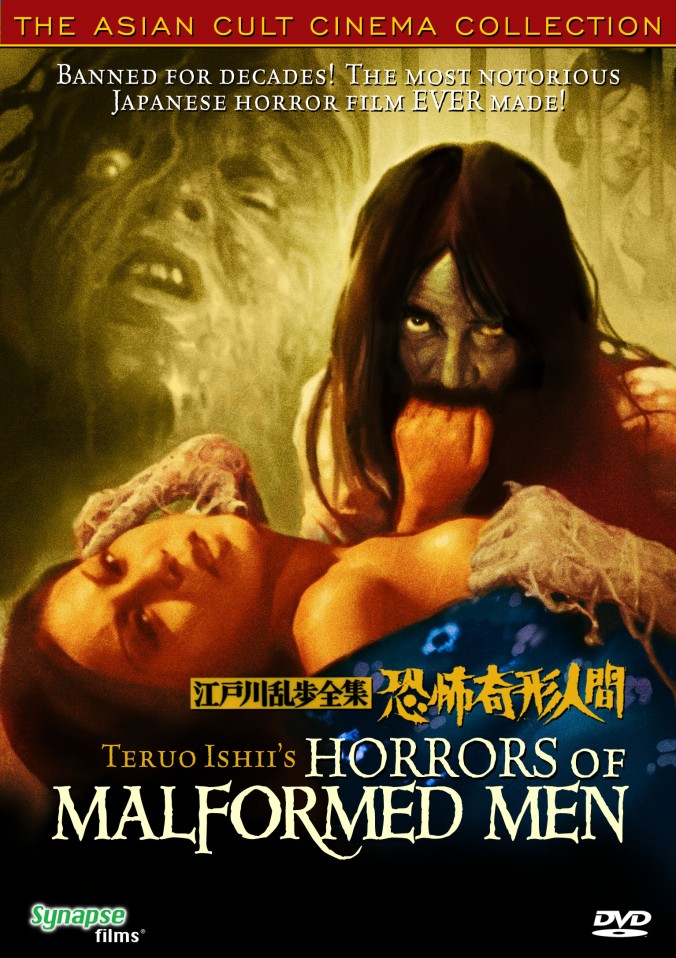
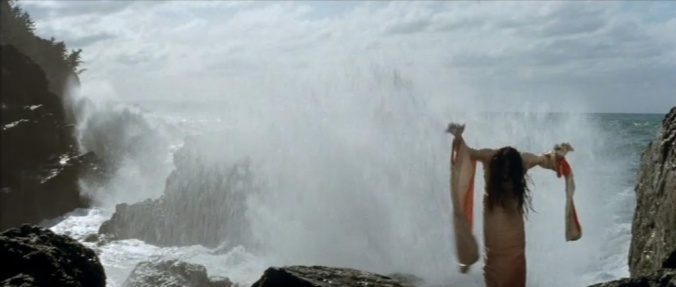
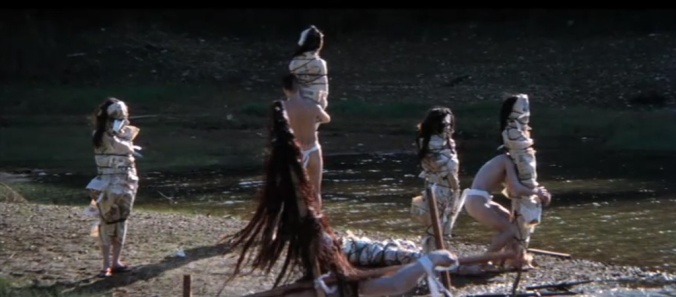
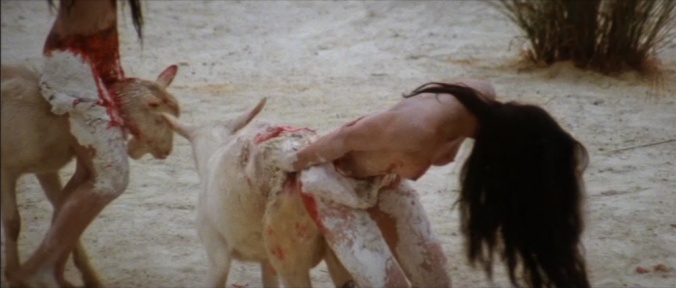
Pingback: Deviant Desires: Erotic Grotesque Nonsense, part II. Edogawa Rampo. | Lady Lazarus: dying is an art
I have always wondered about this movie! I am a Butoh dancer and am so curious about Hijikata’s performance in the film! Your blog has inspired me to rent it!
Butoh is such a beautiful art form. I admire it greatly. You should definitely seek out this film if, for no other reason, you’d like to see one of the originators of Butoh perform.
Thanks! I actually just borrowed it from a friend and can’t wait until I have time to enjoy it!
Great! Prepare yourself for a crazy ride. The ending in particular is gloriously nuts.
Pingback: Deviant Desires: Erotic Grotesque Nonsense, Part IV: “Midori — The Girl in the Freak Show” | Lady Lazarus: dying is an art